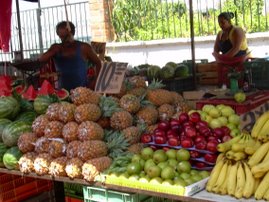 These two boys were the good-natured parking attendants in Tonala, a district of Guadalajara, where my son, Eric, my daughter, Wendy, and I went to do some last minute Christmas shopping last week. I thought these guys were so cute biding their time to collect the money from the people who park there. Tonala is an interesting place where many of the Mexican pottery and other crafts are made. The shops and street vendors sell many wares for cheap prices, so we had lots of fun browsing. We ate lunch at a nice little garden restaurant and generally had a wonderful time. I did get lost, not because I didn't know the way to Tonala, but because I was waxing eloquent to the kids about the ups and downs of living in Mexico, and I missed the turn. Nevertheless, we found it and had a wonderful time. Here are a couple more photos of Tonala:
These two boys were the good-natured parking attendants in Tonala, a district of Guadalajara, where my son, Eric, my daughter, Wendy, and I went to do some last minute Christmas shopping last week. I thought these guys were so cute biding their time to collect the money from the people who park there. Tonala is an interesting place where many of the Mexican pottery and other crafts are made. The shops and street vendors sell many wares for cheap prices, so we had lots of fun browsing. We ate lunch at a nice little garden restaurant and generally had a wonderful time. I did get lost, not because I didn't know the way to Tonala, but because I was waxing eloquent to the kids about the ups and downs of living in Mexico, and I missed the turn. Nevertheless, we found it and had a wonderful time. Here are a couple more photos of Tonala:
We enjoyed a wonderful Christmas with TWO of our three children. Cassie was scheduled to fly out of Boston to Guadalajara on Monday December 21, but her flight was canceled because of the big storm on Saturday the 19th. Unbelievably, she was unable to get re-booked before Christmas Eve, very late, and would have had to leave on the 27th, so she decided to reschedule for March, when she could have a full week visit. So we missed having everyone together, which was sad.
We did, of course, enjoy having Isabelle here with Eric. She is almost two and full of beans! She kept Eric, particularly, very busy, but we all were loving having her around. So here are the latest Isabelle photos:


One of the things about experiencing Christmas in Mexico is that it sure doesn't seem like Christmastime, especially if you come from Maine. Even though we have a bit if a chill in the morning, requiring you to wear, perhaps, a sweatshirt, "Let it Snow, Let it Snow, Let it Snow" does not really ring true. On the other hand, this is a very devout Christian country, so there are reminders of the true meaning of Christmas everywhere. We went to the neighboring town of San Antonio Tlaycapan to experience a traditional posada, where the nativity is reenacted. Young people dressed as Mary and Joseph proceed through town stopping at homes to ask if they can stay for the night. Each home, of course, turns them away until they find the special house with the manger. Hundreds of townspeople follow the procession, singing Christmas songs. They finally end up at the church for the special ceremony. Here are some photos:


On Chrisrtmas Eve, we went to the church in Ajijic and witnessed the very serious nativity scenes being reenacted by young couples with babies:


And here is a rear view of the "naciamento" or cheche, in the gazebo in Ajijic. It is up for the entire Christmas season, but it doesn't include a baby Jesus until Christmas eve.
 So, we had a wonderful, yet simple, Mexican Christmas. We capped off the week with a trip to the Guadalajara Zoo on the day after Christmas. This is an excellent zoo, complete with a safari ride through an African landscape, complete with lions, zebras, antelopes, and giraffes, who come up to the vehicle we ride in so we can feed them carrots:
So, we had a wonderful, yet simple, Mexican Christmas. We capped off the week with a trip to the Guadalajara Zoo on the day after Christmas. This is an excellent zoo, complete with a safari ride through an African landscape, complete with lions, zebras, antelopes, and giraffes, who come up to the vehicle we ride in so we can feed them carrots:

Well, Eric and Isabelle made it back to Indiana and Wendy made it back to Maine...and we were left with an empty nest...until this morning, when we found a lady from Guadalajara who was selling Shi Tzu puppies. So I am pleased to introduce all the readers of this blog to our new puppy. Please meet Chuy!
 In Mexico, Chuy is a nickname for Jesus. It is pronounced "Chewy." He is six and a half weeks old, weighs three pounds, and has already developed an appealing personality. His image will likely appear frequently in future posts on this blog as he becomes housebroken and worms his way into our life. We can never replace Maggie, but this little guy will help us fill the hole left in our life by her absence.
In Mexico, Chuy is a nickname for Jesus. It is pronounced "Chewy." He is six and a half weeks old, weighs three pounds, and has already developed an appealing personality. His image will likely appear frequently in future posts on this blog as he becomes housebroken and worms his way into our life. We can never replace Maggie, but this little guy will help us fill the hole left in our life by her absence. So, good bye 2009. It wasn't our greatest year, but it had its good points. May we all have a prosperous and healthy 2010. May we learn to live in peace, may the United States enjoy a better, more equitable health care system, and may the United States of Mexico enjoy a joyous and peaceful bicentennial year!











































































































